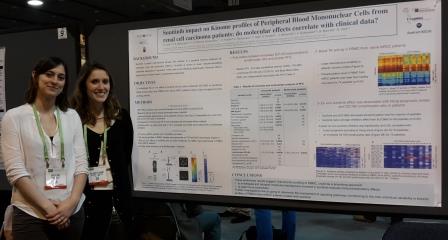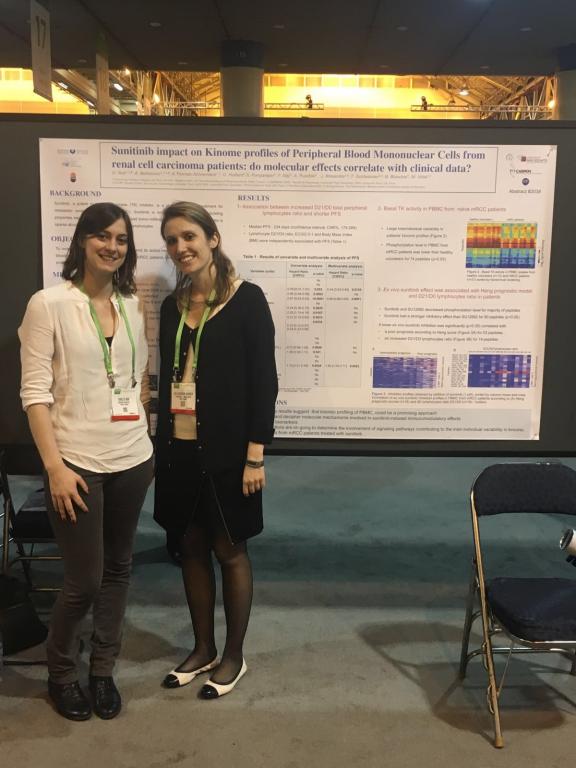Clinical efficacy of Sunitinib from blood samples of mRCC patients? Novel and interesting findings were presented at the 2016 annual meeting of the American Association of Cancer Research (AACR) by Gaëlle Noé from the group of Prof. Vidal, Cochin Hospital, Paris. These researchers sought to find out whether PBMCs could be an interesting model to obtain biomarkers predicting the clinical efficacy of Sunitinib, in mRCC.


Contact Gaëlle Noé for more information (gaelle.noe@aphp.fr)
Download poster PDF:
Download
Abstract Number: 2038
Presentation Title: Sunitinib impact on kinome profiles of peripheral blood mononuclear cells from renal cell carcinoma patients: Do molecular effects correlate with clinical data?
Presentation Time: Monday, Apr 18, 2016, 1:00 PM – 5:00 PM
Location: Section 14 Poster Board Number: 10
Author Block: Audrey Bellesoeur1, Gaelle Noe1, Audrey Thomas-Schoemann1, Olivier Huillard1, Faris Naji2, Savithri Rangarajan2, Alicja Puszkiel1, Jerome Alexandre1, François Goldwasser1, Benoit Blanchet1, Michel Vidal1. 1Cochin Teaching Hospital, Paris, France; 2PamGene International BV, Netherlands
Abstract Body:Introduction: Sunitinib, a potent multi-tyrosine kinase (TK) inhibitor, is a standard first-line treatment for metastatic renal cell carcinoma (mRCC). In addition to its antiangiogenic activity, sunitinib is known to have immune-modulating properties especially on regulatory T-cells and tumor-infiltrating lymphocytes. However, data is sparse about sunitinib impact on peripheral lymphocytes and new data is needed to gain insights into the angiogenesis and immunity bidirectional link. This study aims to fill such a gap by investigating the clinical and intracellular modifications of sunitinib on peripheral blood mononuclear cells (PBMC) from naïve mRCC patients.
Methods: Initially, a retrospective study was conducted in 88 mRCC patients treated with first-line sunitinib therapy to assess the evolution of lymphocyte count (expressed as a ratio between Day 21 and Day 0 i.e. D21/D0) during the first cycle of treatment. A new prospective study was carried out to determine kinomic profiles in PBMC from 21 naïve mRCC patients and 12 healthy volunteers. TK activity profiles of PBMC lysates were generated on TK PamChip® microarrays. The ex vivo effect of sunitinib and its active metabolite SU12662 were also determined in PBMCs. All data were analyzed using BioNavigator software.
Results: The retrospective preliminary study showed that an increased D21/D0 lymphocytes ratio was significantly associated with a shorter Progression Free Survival (PFS) in multivariate analysis (p=0.0023). In the prospective study, the phosphorylation level in PBMCs from mRCC patients was significantly lower than in healthy volunteers for 74 peptides (p<0.05). Ex vivo exposure to sunitinib or SU12662 led to a decreased phosphorylation level for majority of peptides in PBMCs from mRCC patients. Moreover, sunitinib had a stronger inhibitory profile than SU12662 for 80 peptides (p<0.05). The ex vivo sunitinib effect was statistically correlated with the IMDC (“Heng”) prognostic model and D21/D0 lymphocytes ratio and 53 and 16 peptides, respectively were found to be significant. Less ex vivo inhibition was associated with both a poor prognosis according to Heng and an increased D21/D0 lymphocytes ratio.
Conclusions: Our retrospective study shows a decreased lymphocyte count on D21 after sunitinib initiation is a favorable prognostic factor in mRCC patients. The kinomic analysis of TKs in PBMCs after ex vivo exposure to sunitinib correlates with both Heng prognostic score and lymphocyte D21/D0 ratio, suggesting that PBMCs could be an interesting biological matrix to seek future biomarkers regarding clinical efficacy of sunitinib. Further investigations are underway to determine the involvement of signaling pathways contributing to the inter-individual variability in kinomic profiles of PBMCs from mRCC patients treated with sunitinib.



